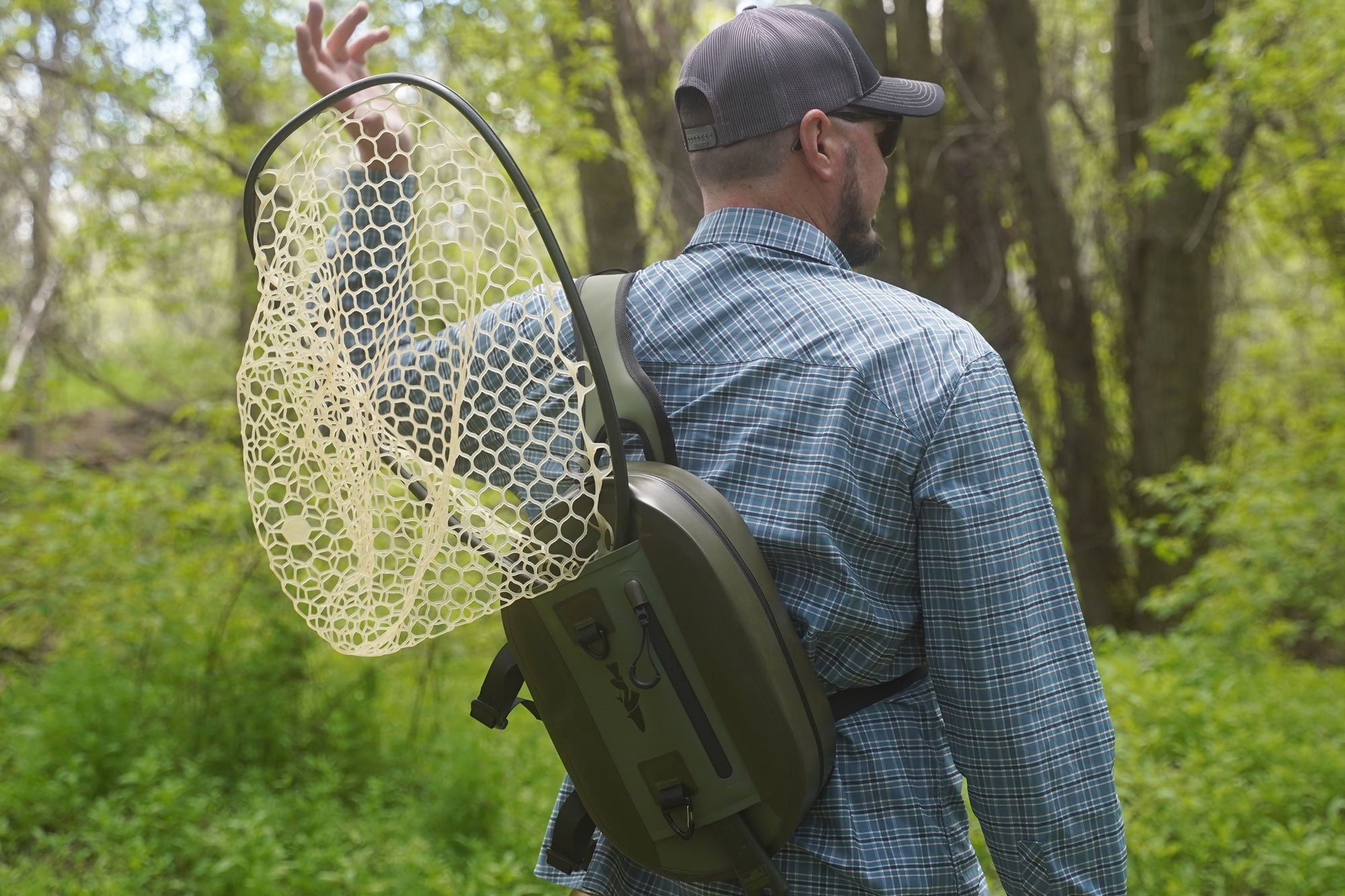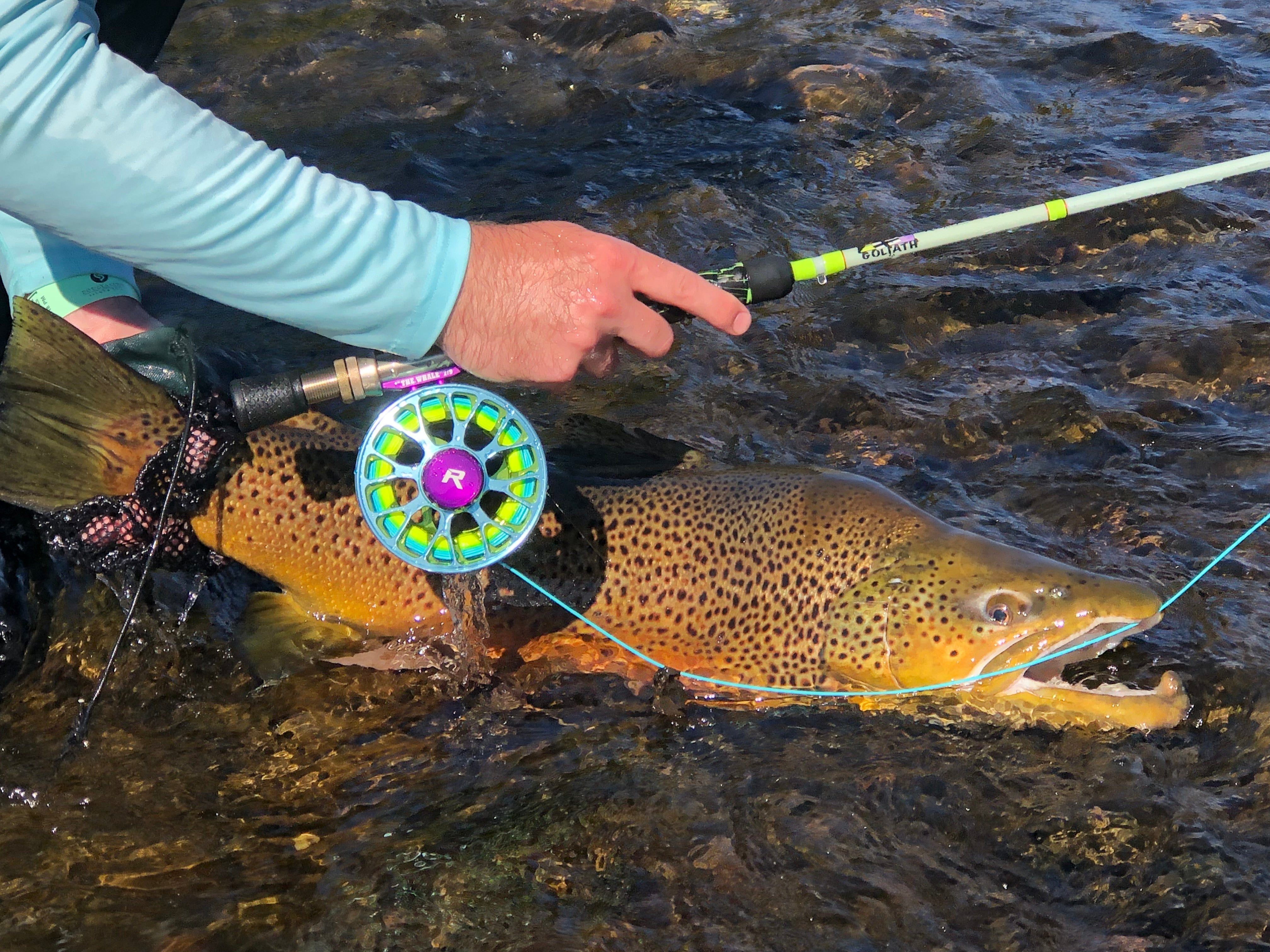Beyond Indicators: The Direct Connection Revolution
Long line naked nymphing, also known as "going naked" or "contact nymphing," represents one of the most sophisticated techniques in stillwater fly fishing. By eliminating strike indicators and maintaining direct contact with your flies through long leaders, this method provides unparalleled sensitivity for detecting subtle takes while offering incredibly natural presentations that fool even the most educated trout.
This advanced technique requires developed skills and patience but rewards practitioners with increased catch rates, larger fish, and a deeper connection to the water. When mastered, naked nymphing becomes the go-to method for technical stillwater situations where traditional indicator fishing fails.
WATCH: Phil Rowley demonstrates the advanced nymphing technique
Understanding Naked Nymphing Principles
What Makes It "Naked"
No Indicators:
- Direct Contact: Uninterrupted connection between angler and fly
- Enhanced Sensitivity: Feel even the subtlest takes
- Natural Presentation: No artificial indicator to spook fish
- Stealth Factor: Less visible disturbance on water surface
Long Leader Systems:
- Length: 15-25 feet for most applications
- Direct Transfer: Energy and sensitivity transfer through leader
- Precise Control: Exact depth and speed management
- Natural Drift: Fly behaves naturally without indicator influence
The Physics of Contact
Energy Transfer Principles:
- Leader Tension: Maintained contact transfers strike energy
- Rod Sensitivity: Feel transmitted directly through rod tip
- Line Management: Proper tension crucial for detection
- Environmental Factors: Wind and current affect sensitivity
Strike Detection Mechanisms:
- Tactile: Feel strikes through rod and line
- Visual: Watch leader and line tip for movement
- Vibration: Sense fish contact through equipment
- Experience: Recognition improves with practice
Equipment for Naked Nymphing Success
Specialized Rod Requirements
Length Considerations:
- 9-10 Feet: Optimal for most naked nymphing applications
- Longer Options: 10-11 feet for maximum reach and control
- Shorter Compromise: 9 feet minimum for adequate performance
- Personal Preference: Balance between control and handling
Action and Sensitivity:
- Medium-Fast: Best balance of sensitivity and power
- High Modulus: Enhanced feel and strike detection
- Lightweight: Reduces fatigue during long sessions
- Quality Construction: Consistent performance essential
Recommended Rods:
- Sage X: Premium sensitivity and performance
- Orvis Helios: Excellent balance and feel
- Scott Centric: Outstanding sensitivity for naked nymphing
- Winston Air: Lightweight with exceptional feel
Line Selection Critical Factors
Floating Line Characteristics:
- Weight Forward: Better casting with long leaders
- Long Head: Smooth energy transfer to leader
- High Float: Stays on surface for visual reference
- Durability: Withstands extended use and cleaning
Specialized Lines:
- RIO Elite Perception: Designed for indicator-free fishing
- Scientific Anglers Amplitude: Enhanced feel and control
- Cortland 444 Classic: Traditional choice for naked nymphing
- Airflo Super-Dri: Excellent floating characteristics
Leader Construction Mastery
Advanced Leader Building:
- Butt Section: 3-4 feet of heavy mono (20-25 lb)
- Taper Section: Gradual reduction to fishing strength
- Tippet Section: 3-6 feet of fluorocarbon
- Total Length: 25% longer than water depth
Critical Measurements:
- Depth Formula: Leader length = water depth × 1.25
- Taper Ratios: Gradual diameter reduction for energy transfer
- Connection Points: Smooth knots for easy casting
- Backup Systems: Carry pre-built leaders for efficiency
WATCH: Building leaders for naked nymphing success
The Naked Nymphing Technique
Setup and Positioning
Boat Positioning:
- Wind Awareness: Use wind for natural drift
- Anchor Strategy: Secure positioning for consistent presentations
- Depth Selection: Target appropriate depth zones
- Casting Angles: Plan multiple approach angles
Shore Fishing Adaptations:
- Deep Water Access: Cast to reach appropriate depths
- Wind Utilization: Use shoreline wind patterns
- Structure Awareness: Avoid snags and obstacles
- Movement Strategy: Cover water systematically
The Basic Naked Drift
Cast and Setup:
- Accurate Casting: Place flies in target zone
- Line Management: Control line on water surface
- Sink Time: Allow flies to reach desired depth
- Contact Establishment: Take up slack without disturbing flies
Maintaining Contact:
- Rod Position: Keep tip 12 inches above water
- Line Tension: Slight tension without pulling flies
- Drift Following: Move rod to follow natural drift
- Strike Readiness: Stay alert for any resistance change
The Retrieve Process:
- Slow Speed: Barely perceptible movement
- Natural Rhythm: Match water movement patterns
- Pause Integration: Stops trigger strikes
- Depth Maintenance: Keep flies in productive zone
Advanced Contact Techniques
The Lift Method:
- Concept: Slow upward rod movement
- Execution: Gradual lift mimicking emerging insects
- Strike Trigger: Lift often triggers immediate take
- Reset: Lower rod and repeat process
Induced Take Technique:
- Theory: Slight movement suggests vulnerability
- Application: Tiny rod tip movements
- Timing: Vary timing to avoid patterns
- Subtlety: Minimal movement for maximum effect
Following Technique:
- Natural Drift: Rod follows fly drift exactly
- Zero Drag: Completely drag-free presentation
- Sensitivity: Maximum feel for subtle takes
- Patience: Extended periods of following
Fly Selection for Contact Nymphing
Weight and Sink Rate Considerations
Weighted vs. Unweighted:
- Weighted Flies: Get to depth quickly
- Unweighted: More natural presentation
- Mixed Systems: Combine for depth variation
- Environmental: Adjust for current and depth
Tungsten vs. Lead:
- Tungsten: Faster sink, smaller profile
- Lead: Traditional choice, good availability
- Brass: Slower sink, subtle presentation
- Weight Placement: Head vs. body weighting
Effective Naked Nymphing Patterns
Classic Nymph Patterns:
- Pheasant Tail: Universal appeal and natural profile
- Hare's Ear: Buggy appearance triggers strikes
- Prince Nymph: Attractor qualities for aggressive fish
- Copper John: Flash and weight for deeper water
Chironomid Patterns:
- TDC: Excellent for naked presentations
- Zebra Midge: Simple but effective
- Chromie: Flash attracts from distance
- Emerging Patterns: Match specific emergence stages
Specialized Contact Patterns:
- Perdigon: European competition influence
- Hot Spot: Trigger point for aggressive fish
- Jig Patterns: Upside-down hook positioning
- Articulated: Movement for larger profile
Multi-Fly Systems
Two-Fly Setups:
- Point Fly: Heavier pattern for depth
- Dropper: Lighter pattern 18-24 inches above
- Spacing: Adequate separation for natural presentation
- Weight Distribution: Proper balance for effective fishing
Three-Fly Systems:
- Complexity: Advanced technique requiring skill
- Depth Coverage: Fish multiple water column levels
- Pattern Variety: Different sizes and types
- Management: Requires careful line control
Strike Detection Mastery
Developing Sensitivity
Physical Awareness:
- Hand Position: Optimal grip for sensitivity
- Rod Angle: Maintain best angle for feel
- Body Position: Comfortable stance for extended fishing
- Concentration: Focus entirely on strike detection
Visual Cues:
- Line Tip Watching: Monitor for any movement
- Leader Behavior: Watch for unusual leader action
- Water Surface: Look for subtle disturbances
- Rod Tip: Watch for slight bending or movement
Types of Takes in Naked Nymphing
Aggressive Takes:
- Obvious: Easy to detect and hook
- Response: Quick but controlled hook set
- Fighting: Fish often hooked well
- Less Common: Represent minority of takes
Subtle Takes:
- Light Touch: Barely perceptible contact
- Detection: Requires high sensitivity
- Response: Gentle tightening rather than setting
- Most Common: Majority of naked nymphing takes
Pressure Changes:
- Weight Increase: Sudden heaviness in line
- Detection: Feel rather than see
- Response: Lift rod to establish contact
- Following: Continue pressure to hook fish
🎥 WATCH: Recognizing and responding to subtle takes
<!-- YouTube Video Embed -->
<div class="video-container">
<iframe width="560" height="315"
src="https://www.youtube.com/embed/[VIDEO_ID]"
title="Strike Detection in Naked Nymphing"
frameborder="0"
allow="accelerometer; autoplay; clipboard-write; encrypted-media; gyroscope; picture-in-picture"
allowfullscreen>
</iframe>
</div>
<!-- End YouTube Video Embed -->
Seasonal Applications
Spring Naked Nymphing
Cold Water Advantages:
- Lethargic Fish: More likely to mouth flies gently
- Clear Water: Stealth presentation more important
- Subtle Takes: Enhanced sensitivity crucial
- Extended Drifts: Fish require longer to decide
Spring Techniques:
- Slow Presentations: Match fish metabolism
- Small Patterns: Match early season insects
- Deep Focus: Fish in thermally stable deeper areas
- Patience: Extended periods between takes
Summer Strategies
Warm Water Adaptations:
- Deeper Fishing: Fish seek cooler water
- Faster Takes: Fish more aggressive in warm water
- Multiple Patterns: Varied presentations needed
- Thermal Targeting: Fish thermal break areas
Hot Weather Tactics:
- Early/Late: Avoid midday heat
- Shade Focus: Target shaded areas
- Deep Water: Use technique in deeper zones
- Activity Timing: Match fish activity periods
Fall Excellence
Pre-Winter Feeding:
- Aggressive Fish: Fish feed heavily before winter
- Larger Patterns: Fish willing to take bigger offerings
- Extended Opportunities: Stable weather periods
- Technique Refinement: Perfect timing for skill development
Fall Advantages:
- Active Fish: Increased feeding creates more opportunities
- Comfortable Conditions: Pleasant fishing weather
- Skill Development: Ideal time for learning technique
- Trophy Potential: Large fish feeding aggressively
Advanced Naked Nymphing Strategies
Reading Water for Contact Fishing
Depth Selection:
- Sweet Spots: 12-20 feet ideal for technique
- Structure Relation: Fish near but not on structure
- Current Edges: Target transitional areas
- Thermal Zones: Fish temperature break areas
Fish Location Indicators:
- Rising Fish: Surface activity indicates presence
- Baitfish: Small fish indicate predator presence
- Bird Activity: Diving birds suggest fish activity
- Sonar Marks: Electronic confirmation of fish presence
Weather and Timing Considerations
Optimal Conditions:
- Overcast: Reduces fish spookiness
- Light Wind: Aids natural presentation
- Stable Pressure: Fish more likely to feed
- Comfortable Temperature: Extended fishing opportunities
Challenging Conditions:
- Bright Sun: Fish become more cautious
- Heavy Wind: Difficult line management
- Pressure Changes: Fish may be less active
- Temperature Extremes: Fish activity reduced
Combining with Other Techniques
Naked to Indicator:
- Start Naked: Begin with sensitive technique
- Switch When Needed: Use indicators if conditions warrant
- Comparison: Compare effectiveness of different methods
- Adaptation: Choose best technique for conditions
European Influences:
- Competition Techniques: Adapt contest methods
- Tight Line Principles: Apply river techniques to stillwater
- Advanced Rigs: Use sophisticated leader systems
- Indicator Alternatives: Czech and Polish methods
🎥 WATCH: Advanced naked nymphing strategies and adaptations
<!-- YouTube Video Embed -->
<div class="video-container">
<iframe width="560" height="315"
src="https://www.youtube.com/embed/[VIDEO_ID]"
title="Advanced Naked Nymphing Strategies"
frameborder="0"
allow="accelerometer; autoplay; clipboard-write; encrypted-media; gyroscope; picture-in-picture"
allowfullscreen>
</iframe>
</div>
<!-- End YouTube Video Embed -->
Troubleshooting Common Problems
Casting Long Leaders
Common Issues:
- Leader Tangles: Wind knots and tangles
- Poor Turnover: Leader doesn't straighten
- Splash Down: Heavy landing spooks fish
- Distance Problems: Can't reach desired casting distance
Solutions:
- Open Loops: Use wider casting loops
- Slow Timing: Allow time for leader extension
- Smooth Acceleration: Gradual power application
- Practice: Develop muscle memory for long leaders
Strike Detection Difficulties
Sensitivity Problems:
- Missing Takes: Not detecting subtle strikes
- False Alarms: Setting hook on non-strikes
- Delayed Response: Too slow to react
- Inconsistent: Sometimes detect, sometimes miss
Improvement Strategies:
- Practice: Regular sessions to develop feel
- Concentration: Complete focus during fishing
- Equipment: Ensure optimal rod and line selection
- Technique: Proper contact maintenance
Depth Control Issues
Common Challenges:
- Too Shallow: Flies not reaching fish level
- Too Deep: Flies dragging bottom
- Inconsistent: Depth varies throughout drift
- Unknown: Uncertainty about fly depth
Management Solutions:
- Count System: Develop consistent timing method
- Leader Calculation: Use mathematical formulas
- Experience: Build depth sense through practice
- Reference Points: Use landmarks for consistency
Building Naked Nymphing Skills
Progressive Learning Path
Beginner Phase (Months 1-3):
- Basic Casting: Master long leader casting
- Contact Basics: Learn to maintain proper contact
- Simple Rigs: Start with single fly setups
- Strike Recognition: Develop basic sensitivity
Intermediate Level (Months 4-12):
- Advanced Rigs: Progress to multi-fly systems
- Condition Reading: Adapt to various conditions
- Technique Refinement: Perfect retrieve methods
- Pattern Selection: Choose appropriate flies
Expert Mastery (Year 2+):
- Innovation: Develop personal variations
- Teaching: Help others learn technique
- Competition: Apply in competitive situations
- Integration: Combine with other advanced methods
Practice Opportunities
Ideal Learning Waters:
- Clear Lakes: Visual feedback for technique development
- Known Populations: Consistent fish presence for practice
- Appropriate Depth: 12-20 feet for optimal learning
- Protected Areas: Minimal wind for skill development
Skill Development Exercises:
- Casting Practice: Regular long leader casting sessions
- Sensitivity Training: Practice on known fish locations
- Depth Experiments: Fish various depths systematically
- Strike Recognition: Learn to identify different take types
Conservation and Ethics
Responsible Naked Nymphing
Fish Handling:
- Gentle Techniques: Naked nymphing often deeply hooks fish
- Quick Release: Minimize time out of water
- Proper Tools: Use appropriate landing nets and tools
- Barbless Hooks: Reduce fish injury and ease release
Environmental Stewardship:
- Minimal Impact: Avoid disturbing spawning areas
- Leader Responsibility: Pack out all tippet and leaders
- Education: Teach others responsible techniques
- Conservation Support: Support stillwater habitat protection
Sharing Knowledge
Teaching Considerations:
- Safety First: Emphasize safe techniques and equipment
- Skill Progression: Teach in logical sequence
- Practice Emphasis: Stress importance of regular practice
- Patience Development: Help others develop required patience
The Naked Advantage in Stillwater Fly Fishing
Naked nymphing represents the pinnacle of sophisticated stillwater technique. When mastered, it provides unparalleled sensitivity, natural presentations, and connection to the water that enhances every aspect of your stillwater fishing. The technique demands patience, practice, and persistence, but rewards dedicated practitioners with increased success and deeper understanding of fish behavior.
This advanced method opens up fishing opportunities that traditional indicator techniques cannot access. The ability to detect the subtlest takes, present flies with perfect naturalness, and maintain direct contact with your flies throughout the drift creates advantages that experienced stillwater anglers prize above all others.
Remember that naked nymphing is not a replacement for all other techniques but rather the ultimate tool for technical situations. Master this method, and you'll have access to the most sophisticated presentation in stillwater fly fishing – one that consistently catches educated fish and provides the deepest connection between angler and fish.
Ready to develop the most sensitive technique in stillwater fishing? Start with proper equipment, practice long leader casting, and prepare for a learning curve that will transform your understanding of fish behavior. The rewards are worth the effort.
SEO Keywords targeted: naked nymphing, long line nymphing, stillwater fly fishing, fly fishing stillwater, contact nymphing, advanced stillwater techniques, sensitive fishing methods, indicator-free fishing, stillwater nymphing
Related Videos: Search YouTube for "naked nymphing," "Phil Rowley stillwater," "contact nymphing," and "advanced stillwater techniques" to find the latest instructional content from top stillwater experts.






